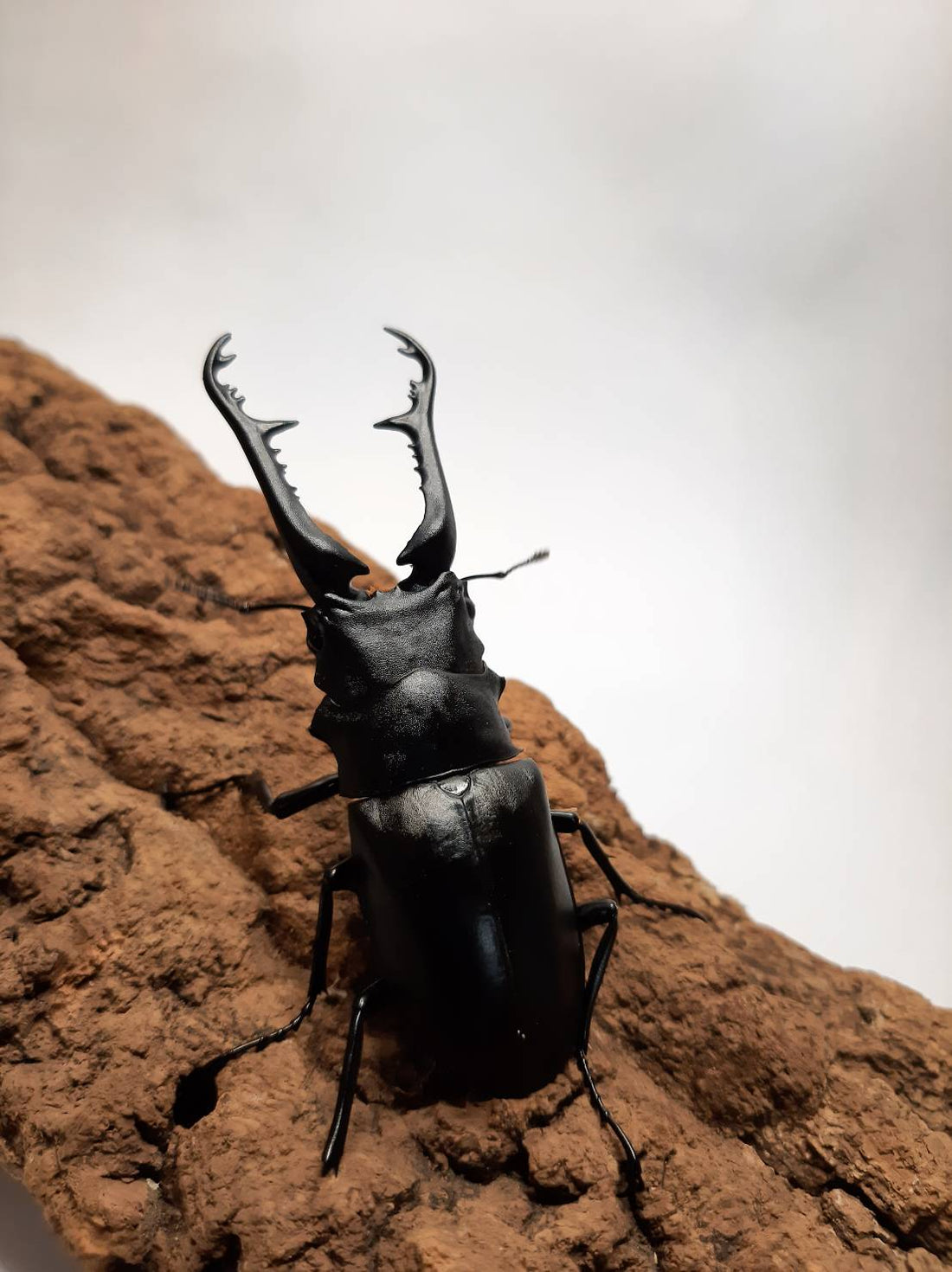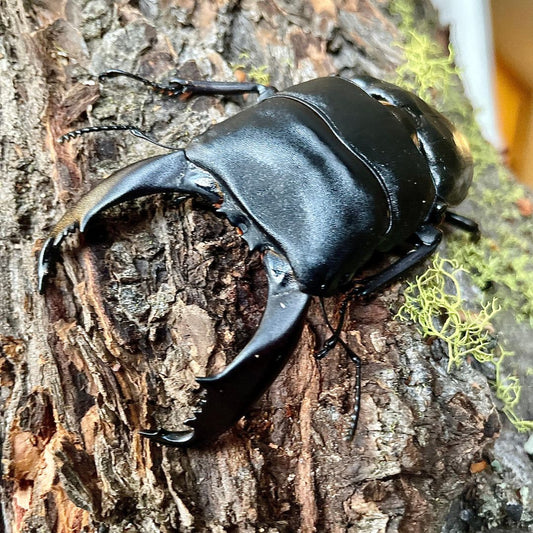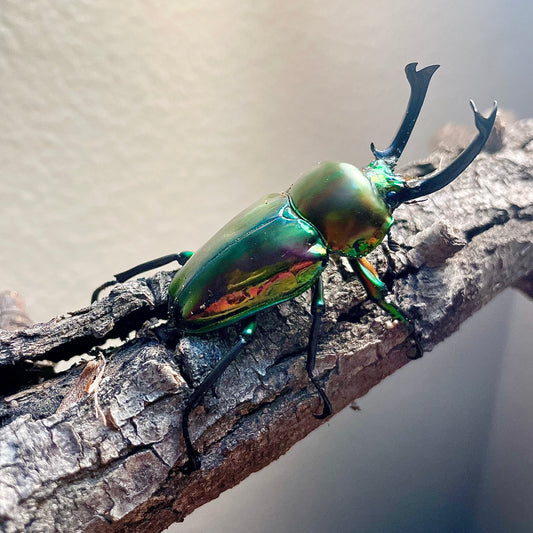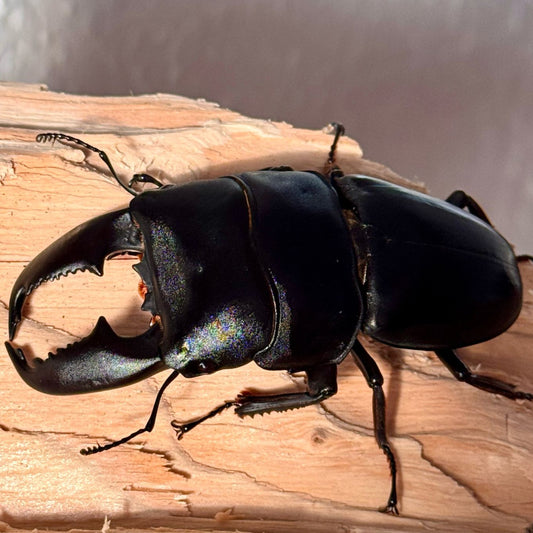Beetles are incredible insects that you can find all around the world. They come in many different shapes, sizes, and colors. In this introduction, we'll cover what beetles are, the types of beetles you might encounter, their life cycle, and what you should know if you want to have a beetle as a pet.
What is a Beetle?
Beetles are insects, and they're part of the order Coleoptera. What makes them special is that they have a hard shell-like covering called an exoskeleton. This exoskeleton protects their bodies and gives them a unique look. They also have two pairs of wings, with the front pair being hard and forming a protective shield. Beetles are incredibly diverse, with over 350,000 different species known to science!
Types of Beetles
Beetles come in all sorts of varieties. Some common types you might have heard of include Rhino Beetles, Stag Beetles, and Flower beetles, showcase the diversity and unique features of the beetle world. From the horned Rhino Beetles to the stag-like mandibles of Stag Beetles and the colorful, flower-feeding habits of Flower Beetles, each type has its own captivating characteristics that make them a fascinating part of the natural world.
- Rhino Beetles:
Rhino Beetles are known for their impressive size and the characteristic horn-like projections on their heads, which resemble the horns of rhinoceroses. These projections are more prominent in males and are used for fighting with other males over mates or territory.
Habitat: Rhino Beetles are often found in tropical and subtropical regions around the world, living in wooded areas and forests. They typically dwell in rotting wood or the leaf litter on the forest floor.
Diet: As adults, Rhino Beetles usually feed on sap, fruits, and nectar. The larvae, on the other hand, are often decomposers, breaking down dead wood and plant material.
- Stag Beetles:
Stag Beetles are named for their large, distinctive mandibles (jaws) that resemble the antlers of deer. These mandibles are primarily used by males for combat and attracting mates.
Habitat: Stag Beetles can be found in various parts of the world, often residing in wooded areas, gardens, and parks. They are often associated with oak trees, where they lay their eggs.
Diet: As adults, Stag Beetles mainly feed on tree sap and fruit juices. Their larvae feed on decaying wood and leaf litter in tree stumps and fallen logs.
- Flower Beetles:
Flower Beetles, also known as Scarab Beetles, come in a variety of shapes and sizes. They often have colorful, iridescent shells and are named for their attraction to flowers.
Habitat: Flower Beetles can be found in many parts of the world, and their habitats vary depending on the species. They are often associated with gardens, where they feed on flower nectar and pollen.
Diet: Flower Beetles are typically nectar feeders as adults. They play an essential role in pollinating flowers. Some species also feed on rotting vegetation and dung as larvae.
Life Cycle of Beetles
Beetles go through a life cycle just like many other insects. The developmental stages of Stag Beetles, Rhinoceros Beetles, and Flower Beetles involve a series of molts, progressing from eggs to emerging adults. It has four main stages:
- Egg Stage:
The life cycle of these beetles begins when adult females lay their eggs. Typically, the eggs are laid in a suitable environment, often near or within decomposing wood or organic matter.
- First-Instar Larva (L1):
After hatching from the egg, the young beetle enters the first-instar larval stage (L1). At this stage, the larva is quite small and feeds on the surrounding organic material. L1 is generally a short stage.
- Second-Instar Larva (L2):
Following the first molt, the larva advances to the second-instar stage (L2). In this stage, the larva continues to grow and develop, and its body proportions change.
- Third-Instar Larva (L3):
The third-instar larval stage (L3) is the longest stage in the developmental process. During this stage, the larva grows significantly and may develop distinctive characteristics, depending on the beetle species. For some species, such as Rhinoceros Beetles and Stag Beetles, L3 is when the larvae can grow large and develop their characteristic features, like impressive mandibles.
- Pupa:
After completing the third larval instar, the larva enters the pupal stage. This is a resting phase during which the larva undergoes metamorphosis, transforming into an adult beetle.
- Emerging Adult:
Finally, the pupa transforms into the adult beetle. This is the stage where the beetle takes its final form, with wings, antennae, and all the characteristics typical of its species. The emerging adult is ready to continue the life cycle by seeking a mate and reproducing.
The duration of each stage can vary depending on factors such as environmental conditions, temperature, and the specific species of beetle. The transformation from egg to adult is a remarkable process that showcases the unique life cycle of these beetles.



